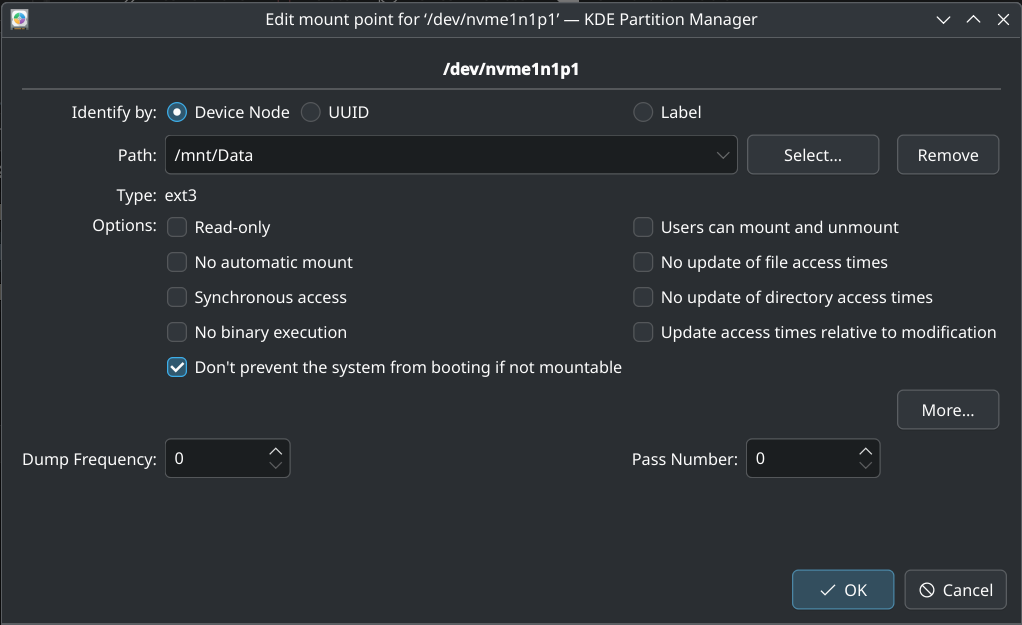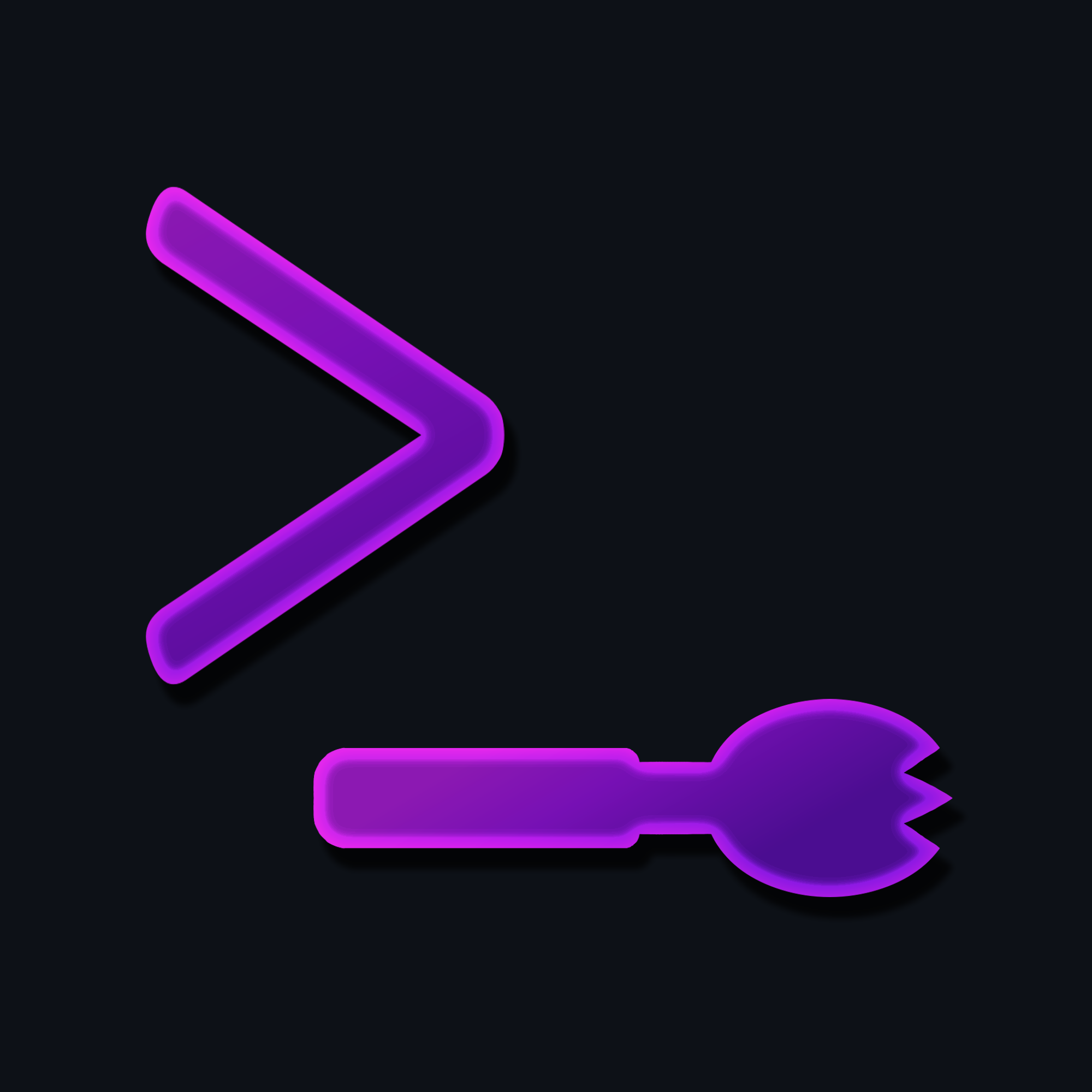
deleted by creator
Proton the gaming tool
Skill issue
deleted by creator
I really, REALLY wish the Affinity suite would work on Linux. They are the only ones even remotely comparable to Adobe.
deleted by creator
I use gimp for pixel art for game textures and to make memes. It has tons of features that nobody knows about becuase they’re fucked by horrendous UI. But theres never been anything I needed to to but couldnt after looking up a tutorial on the internet. Valid points against gimp but lets not pretend people used to photoshop arent also kind of stuck in their old workflow habits and unwilling to relearn new software UI.
Theres photogimp but it hasn’t been worked on in a while.
Also also, most people who use gimp on linux probably did so on a stable distro like Mint installing with default package manager. This means their experience with gimp is from a terribly old outdated version. Flatpaks have some issues but being able to easily install the most current version of software like gimp or kdenlive is night and day difference.
Also also, most people who use gimp on linux probably did so on a stable distro like Mint installing with default package manager. This means their experience with gimp is from a terribly old outdated version. Flatpaks have some issues but being able to easily install the most current version of software like gimp or kdenlive is night and day difference.
Another reason to use Gentoo: https://packages.gentoo.org/packages/media-gfx/gimp
You can install 3.0.0rc2 or even git version.
Oh cool! Let me just spend three weeks crawling through wiki articles, setting flags in the config files, and patching out 15 different issues with various drivers then installing 20 dependencies compiling them all from source.
Hyperbole, but yeah no thanks I’ll take the L on some optimization and 2gb of storage space and some wierd file system locations for files to load a flatpak if old stable doesn’t cut it. you might want to be careful recommending gentoo to people they might not know better. Most Linux nerds don’t want to open that can of worms, but good for you if it works.
deleted by creator
Photopea was written by a single college grad, and it’s miles better than gimp. While gimp has more resources and manpowers. Something is seriously wrong with their team.
Photopea blows me away. You can actually follow along in a lot of PS tutorials just using Photopea. It’s got so many features implemented
Photopea uses rendering by browser. And probably doesn’t have plugin system.
And? so what? It doesn’t matter if GIMP has a plugin system. The UI is so shit you have to google everything to figure out how to use it and even then it’s still complicated.
I’m pretty sure Photoshop was better in 2003 than gimp is today
Gimp has a few weak spots but it’s an incredibly capable tool and if you think phone apps can do things it can’t then I don’t think you know how to use it.
You’re telling me this free, volunteer-run feature full software isn’t almost as good as the multi-million dollar product from a multi-billion dollar company?
If this dude can edit his videos and images on Linux so can you Mr Van Gogh. https://youtu.be/lm51xZHZI6g
Yes, that’s what we’re saying. It’s fine though, I don’t expect developers to work miracles for free, they are doing an amazing job, but In the context of “Linux being ready” it’s important to recognize some honest truths.
Users do not care about how hard the devs are working for free. If the software doesn’t have the features, it’s not ready.
Really think about this. You’re saying two entirely contradictory things:
-
Linux software is ready to compete with Windows
-
Users cannot expect Linux software to have comparable features to Windows
How will it compete without comparable features? Passion and morals aren’t valued over effectiveness by most users.
-
deleted by creator
gimp is ass sorry
GIMP’s engine is very good. It’s UI is cuntpuke.
Somebody write a QT front end for Imagemagick and you’ll probably see Linux adoption jump.
You’re telling me this free, volunteer-run feature full software isn’t almost as good as the multi-million dollar product from a multi-billion dollar company?
You’re describing the truth about Linux vs windows, except many Linux oses are better than anything ms makes.
I think Windows could be a far better OS than Linux if Microsoft gave a single shit. Instead they want to add AI and recall and various invasive updates.
The only thing windows has going is the market share.
Could, true, but never has, never will. As long as it uses a janky non-standard kernel underneath, I’m gonna be hating on it.
Yeah. it’s dogshit but they certainly have the capacity to improve. it’s clear where their priorities are: milk users for profit
To run Resolve properly, you apparently have to run DaVinci’s flavor of Rocky Linux 8.6. If you’re doing other things with that machine, this may be undesirable. And as far as I know, there’s no equivalent for After Effects.
I can guarantee you that no app on or for your phone can do a fraction of what GIMP is capable of.
deleted by creator
I’ve been using the Gimp for decades to great effect. Git gud (pin intended). Also, all phone photo editors are garbage.
deleted by creator
Trim my toenails, obviously.
deleted by creator
Image editing.
deleted by creator
What else is the program for? I haven’t used Photoshop since the '90s.
Thanks to the likes of Proton, gaming on Linux is a hell of a lot better than it was ~5 years ago. You can actually do it now for the most part without to much fuss in my experience as long as you stick to Steam.
But once you leave Steam or get something brand new made by an EA type and have to lean on third party implementations of Proton or raw Wine to get things working it gets a lot worse.
But once you leave Steam […] it gets a lot worse
Heroic Games Launcher is pretty great for games from GOG and Epic. You can run games with Proton just fine.
Also, for folks out of the loop, let me explain what this entails. I installed Steam. I clicked install on a game. I clicked play in Steam. That was it. Proton isn’t some sort of thing you need to install or launch separately. It really does “just work”.
I’m able to play Deep Rock Galactic, Helldivers 2, and even Marvel Rivals online just fine. All of these are online multiplayer games, the types that generally seem to have the most trouble on Linux.
that is most definitely not the process. You have to explicitly go into Steam’s settings > Compatibility > “Enable Steam Play for all other titles” (what in the world, it’s called Steam Play, not Proton?) and then additionally select which Proton version you want. If you don’t know this, or don’t google it with the right keywords, you won’t understand why literally 90% of your library isn’t available (in my case it was 99% of my library, I think I only had 3 games available on linux natively). Also if you select the wrong Proton version some games won’t run, so you have to know that and switch it for those games only.
They’re likely using a gaming distro that has those settings enabled by default.
It isn’t perfectly seamless but enabling Steam Play or changing proton versions isn’t any more of an advanced task than verifying game files (something that Windows users are asked to do the moment that they have a problem).
It has come a long way from the days of manually creating wine environments and writing custom launch files.
If you can install Skyrim or Minecraft mods (not using Steam Workshop) then you’re sophisticated enough to game on gaming distros like Pop and Bazzite.
If you can use cheat engine without a guide and write your own mods then you’re ready for Arch.
I’m using CachyOS, I think it was set up out of the box.
deleted by creator
Agreed, but I think it’s important to note that that isn’t because of a shortcoming of Linux, it’s because those companies are incentivized to support platforms that are more suitable for enabling massive profits, that’s what it seems like to me anyways.
“it’s important to note that [insert speculation]”
Um yeah that’s why I qualified it how i did 🙄
It’s not important to note something that is speculative.
“It’s important to note that YarHarSuperstar probably doesn’t even run Linux.”
See?
That’s your opinion and you have the right to express it. I disagree obviously, that’s why if you’ll pay very close attention to the words I used, it says “I think” before I said that.
You start by presenting it as a fact “keep in mind that it’s not because of X, but because of Y” then specify that’s it’s what “it seems like” but don’t provide any proof of, therefore there’s nothing important to note about what you said because you can’t back it with a source.
Getting something brand new from EA is painful on any platform
Can confirm, bought my son a FIFA game on pc that caused so much trouble and confusion on windows with their activation bullshit that I ended up buying him an xbox
deleted by creator
deleted by creator
If the average person can not use your OS, it is not ready. Period.
For example:
Windows - Open File Explorer > Add Network Drive > Find/plug it in > Enter creds > Bam. Ready to go and will automatically log you in at boot. Very nice, very intuitive UI.
Linux - Open Dolphin (or whatever) > Network > Add Network Folder/Find it > Enter creds > Does not automatically mount the drive when booting the computer back up > Must go into fstab to get it to automount > Stop, because that is ridiculous
In my own experience, I was able to get the hang of Windows with no one showing me how a computer ever worked, at the age of 10! Intuitive enough a child can do it.
On Linux, you have to read manuals/documentation, ask random (mostly rude) people on the internet, or give up because why the fuck would I want to go and enter 5 commands just to have something as simple as auto mount a network share? Not intuitive, therefore not easy to learn as you go.
I get it, Linux people like knowing how their computers operate, they like ensuring everything is working the way THEY want to, and that’s awesome! What’s not awesome is recommending Linux to the general populace and then getting upset at them for asking why they can’t do something or why don’t they just do these steps to do whatever it is they are having issues with. Then, you have a person who doesn’t even know what a terminal is confused as hell because they were told Linux is so much better than Windows.
Until we get a more intuitive (GUI focused) way of doing what I would consider normal computer tasks, it will not ever be ready. That’s just the way I see it.
The average person does not mount network drives themselves.
I would hazard a guess that for the truly average user, booting to a desktop with Firefox and LibreOffice installed is like 90% of what they need.
The average person does not mount network drives themselves.
NAS is incredibly common these days. Backing up data is mainstream now. Not 100% of laypeople use NAS, of course, but many.
I think both of our statements are correct.
I bet the absolute number of laypeople using NAS is way up while the percentage of users is still tiny.
Backups being mainstream is awesome, but for them backup means cloud and almost certainly Apple/Google/Microsoft. Even I personally still use crashplan for actual backups primarily because it’s offsite and has unlimited version retention. I might roll my own one of these days though, whether finding some cheap cloud storage or putting a small server at my parents’ house or something like that.
It doesn’t have to specifically be a network drive, I bumped into this exact problem with the ntfs Windows drives I didn’t want to reformat after I switched. Only issue is fstab never worked after weeks of trial and error, so I had to use udisks and just elevate its permissions instead.
I haven’t dealt with it on network drives yet, but just recently I was redoing my main machine and had to decide how to mount some big spinning drives for storing media. The graphical disk manager included with Mint, which is just gnome-disks, made it pretty quick.
I agree. It was a niche scenario.
Meanwhile my experience with automounting network drives with dolphin is
Open Dolphin > Add Network Folder > Enter creds > Check automount box > done
I haven’t had to use the terminal for anything in years. There’s some things I do in the terminal, but that’s because I like it better, not because there isn’t an intuitive way to do it.
The reason guides tell people to use the terminal is because it’s the same across DEs, not because there aren’t DEs that make it more intuitive.
Would I throw a random non techy friend on Linux? No, because it’s not what they’re used to. If they had no computer experience at all though I absolutely would.
No automount check box on openSUSE, my Linux OS.
Also, we’re talking average users here, not some techy people who at least understand the differences between the OS and the file manager they use.
What DE do you use? KDE Partition Manager has a setting for it.

I use KDE!
I’ve looked into this before , so in all seriousness, what options would I choose to make it auto mount without asking for a password?
I see the box for no automatic mount, but I don’t see one that is for auto mounting? I’m assuming the don’t prevent boot… option is pretty self explanatory.
Yeah these were the default settings but it’s what I would leave it at. I chose /mnt/data just for an example but that’s not a bad spot for it either.
After clicking OK it asked if I wanted to let it modify fstab to allow auto mounting. So this should just accomplish what you’re looking for I believe.
Thank you! I’m actually going to try this right now! I believe I used YaST to try this, but not KDE. I’ll report back!
So, I looked into KDE PM, and I guess it would have been more helpful to explain that these drives were made on Windows, and has data that I can not afford to move into a new drive at this moment. So in the mean time I am trying to work between Windows and Linux when one doesn’t do what I’m needing in the moment.
When I double click the ntfs partition in the window, it brings up a partition properties window. At the bottom of this window, I can see the flags section. One is “bios-grub” and the other is “boot”. If I tick the boot option, will that make it auto mount?
Oh I think the flags you’re talking about are the kinds of properties the partition has, not necessarily what actions the OS will perform, if that makes sense. The boot flag just means that it is marked as a bootable partition. I’m guessing it was your primary partition from Windows?
I would just mimic the configuration I showed in my screenshot. You can change the path but just make sure there’s an empty folder that exists at the location you choose. That should write to fstab and cause it to try to mount on boot.
Also, just a heads up, NTFS on Linux can be fickle because Windows can leave the partition in odd states that can cause strange mounting issues. It might be best to mount it as read-only if you’re worried about the data, or better yet make a backup. That said, I have a game drive that’s NTFS that works fine, so take that as you will.
if you want to access NTFS partitions on linux, you should turn off “fast startup” in windows. control panel, energy saving, “choose what the power button does” menu. (so intuitive, eh?)
when that’s ticked in, it will always just hibernate the system after logging out, and that’s a nono, and a big one if dualbooting (even just 2 windowses)
Also, we’re talking average users here
Ah yes, the average user who deals with mounting hard disk partitions all the time…
I mean, I was able to figure out how MS-DOS worked as a child just be flailing on the keyboard and reading the errors. It was “easy” because now I know it while Macintoshes may as well have been alien technology. A “mouse”?, moving windows?, you have to find programs and click on them instead of just typing?
You’re just used to Windows annoyances and not used to Linux annoyances, that’s all.
For example:
Installing and updating a program on Windows is a horror show compared to using a package manager. It expects average users to find, download and run executable files from the Internet and conditions them to approve elevation for anything that asks.
If Windows breaks, how do you troubleshoot it? Maybe Google knows, maybe rebooting fixes it, if not then possibly re-installing the entire OS. It’s so bad that if you work with Windows clients you probably already have an image of a Windows install because troubleshooting is so much of a pain it’s easier to just completely re-image the machine.
Don’t even get me started on how often Microsoft changes the layout of administration tools and system menus or their tendency to change the name of various system components for no logical reason.
I don’t think Linux is for everyone, but only because most everyone already has years of Windows experience and forgets all of the frustration and learning.
If you used Linux for just as long as you’ve used Windows, then editing fstab would seem as trivial a task as pinning an item to the
start bartaskbar, orlaunching a programstarting an app from thesystem traynotification areasystem tray.It’s kinda funny that as a seasoned Linux user, I never had to edit fstab for years. I just use Gnome Disks if I need automount or format a USB drive.
Yeah, ironic they chose dolphin to make that point since I literally just did it in dolphin ~a month ago and it has a checkbox to set up automount for you.
Not on all distros, which again, makes the point of how confusing Linux can be to average users… lol
I don’t think I’ve seen OpenSUSE recommended for beginners.
The vast universe of distros is definitely a confusion & intimidation factor for a lot of people. But we are talking about people who do not choose or install their own OS in the first place.
It was the first distro that got me to really want to stay on it. It’s literally almost perfect. It figures that I would want to stay on a more nuanced distro than I am probably knowledgeable to use, but it’s been so stable since I installed it. :,)
I agree. It’s a part of the conversation I always have when I’m talking about Linux in person with someone. I find it both really fucking awesome, but also kind of a bad thing in the sense of “which distro would you recommend” turns into a thesis. x)
It’s kinda funny that as a seasoned Linux user, I never had to edit fstab for years. I just use Gnome Disks if I need automount or format a USB drive.
LucidNightmare tries artificially complicated ways for niche use cases instead of going the straightforward path and then complains all the time how bad Linux isn’t for average users, as if those would meddle with network drives, disk partitions, etc. at all.
It seems so. An average Windows user wouldn’t meddle with those too. I even saw a Windows user who doesn’t know what C or D is, I would guess because the file explorer doesn’t even show drives as default window for a while now.
Yeah, this one gets me, but you are exactly right with “years of experience”. Something goes wrong on my GFs MacBook or Windows PC and she just googles fixes, something goes wrong on her Steamdeck and she hands it to me “I don’t know how to get around the desktop mode”…GOOGLE IT, LEARN, YOU ARENT STUPID! sigh
I mean atleast in terms of the troubleshooting I’ve had to do it’s much easier on Windows. Sure it can be more finicky but if I have a problem 99% of the time I google it and find someone else having the same problem and worst case scenario atleast reinstalling Windows fixes the problem. When I gave Linux a try the amount of times I googled something and either found an out of date solution that didn’t work or was just told that that doesn’t work and you can’t do that was annoying enough that I gave up and went back to Windows. If Linux works for you that’s great but acting like the problems with Linux are just people not being used to it is wrong.
Linux has problems but he is not wrong that a lot of it is not being used to the OS. Finding solutions on the Internet is like a popularity context, of course there is much more of it for windows but even on Linux there is much more for big distros line Ubuntu than other smaller ones.
Now reinstalling windows is not a solution or a good argument, it is saying the problem cannot be fixed. When I used windows that was also my go to solution and very feel things I solved by googling, but I guess in part because I was not as tech savvy as I am now. But I tell you, when I started with Linux I could find solution for all problems that I have that had solutions, now a lot have changed so you do get that some things are outdated but it is just a matter of paying attention if the solution is old or new (side not rant, sites that do not put date on the articles are the worst).
Oh yeah, I naver had to reinstall a Linux machine, maybe I lucked out and didn’t royally fucked anything, but I could always solve problems with the OS without a reinstall. I guess because more easily you can find and know where things changed, like what config files you changed and you can always make a copy. The works case is like booting a live USB and rolling back the changes if the OS does not boot anymore.
I think it depends on what problems you’re talking about as well. A lot of the problems I faced with Linux was with programs not working or certain features not being supported. Where as with windows the problems tend to be more of bugs or weird behaviors from the os itself. Sure you can say reinstalling isn’t a good solution as it’s annoying to do but if it makes the problem go away it is a solution. Meanwhile on Linux if a program isn’t supported and isn’t popular enough to have people figure out how to make it work it just doesn’t work and there is no work around other than either trying to figure it out yourself or just using windows. Sure you can maybe argue that that’s an experience difference as if you had experience with getting programs to work the figure it out yourself part wouldn’t be hard but if anything I think that shows that it’s not just a different set of experience but also generally requires more experience to be proficient with Linux versus being proficient with Windows. Although that probably comes down more to what you consider as being proficient.
I only say that reinstalling is not solving a problem in the context of troubleshooting and finding a fix. But yes, is not a good solution because it is a pain. I did so much reinstalling in my windows years that one of the best things I did was to learn to create a separated partition to use for data because it make reinstalling so much easier (it was back in the days of winME and it was an event to do a reinstall, we would usually go to a friend’s house with the HD or the whole machine just to be able to backup everything).
About the software it is like I mentioned (maybe in other comment) with hardware compatibility. If it is a windows first software, usually Linux support is done in “best effort”, so always lags behind. This is specially true to closed source software as the community can’t even help. In any case, one sad reality is that programmers usually are terrible at building and packaging software for release, and that is not a Linux only problem. The famous dll hell on older windows were due to terrible packaging. That is why docker is so popular, so people don’t have to bother with packaging.
For FLOSS software what I usually see is in software not on the distro repos and it not being compatible with the distro because the devs don’t build for it. With closed source/binary-only what I see the most is broken dependencies because they build it wrong, targeting the OS libraries instead of bundling everything with the package.
I have like the exact opposite issue. I’ve used windows for most of my life but it’s so so much harder to actually fix issues in windows compared to Linux
And for me, the big reason for this is because windows is a black box, Linux is not. You are always able to dig however deep you’d like in Linux compared to windows. Now, that might not be relevant for a layperson directly, but what it does mean is that someone else can understand the system component intimately and help you.
Meanwhile on windows the amount of “run this command that we auto-post to every issue report that doesn’t work” I’ve seen is ridiculous, and it never solved the problem. And then I try to dig into how to actually solve it, and really struggle so much more.
Also, Microsoft just sucks as a company. Recently I’ve wanted to clone a windows installation to an external drive. Should work fine, right? I could easily get that to work for Linux, and any issue that popped up I could fix. So, tried to use clonezilla, didn’t work. Ok fine, let me reinstall. Turns out Microsoft dropped support for windows on an external drive. Well that’s garbage and dumb, as I’ve used this to my benefit in the past. But turns out, people say it still actually works, you just need to use a third party tool. Which doesn’t inspire confidence, but whatever
And it did work in the end, but it took me many many hours of extra work of trying to figure out what the problem was, giving up, then looking for more information on alternate solutions, then finally finding something that worked, albeit with more work on my part
But if it was a Linux installation I’d have been finished in an hour probably, because I expect that cloning a drive would work without much issue there
Installing programs through Windows is now (thankfully) more align with Linux.
winget install firefox > see two different forms, one from Windows Store (ew) and the one provided and hosted by Mozilla > winget install mozilla.firefox > program installs
When updating: winget upgrade shows available updates > winget upgrade --all updates all the listed programs
Not as good as Linux of course, but much better than the old method you stated. That point I will give to you, as it is still not simple for the average user. “Terminal? WTF is that?”
I generally don’t have any annoyances with Windows because it does the things I need it to. I don’t find a UAC popups as annoying, because it is supposed to help prevent people from messing their computer up. The same could be said for the average person on Linux running random commands they found online because the thing they were expecting their computer to do isn’t doing the thing.
Windows has never broken on me, so I do not have a good rebuttal for that. I can at least say that when Linux has been borked before on my own hardware, I essentially had to put the ISO back on the single USB I owned at the time just to reinstall the entire OS again, because again, I didn’t know anything about Linux at this time. While in Windows, if the computer doesn’t boot properly 3 times, it brings up the Windows Recovery menu that has in plain English what available options you have to get your install back in at least some working manner. Again, you must keep the average person in mind. You and I are not what I would consider average in this context.
Again, point to you for the changes to UI that Micro$oft introduce. Very, very, very stupid UI/UX redesign choices, and without an alternate avenue at that! (there are a few programs that try to replace some of the Windows UI to get it back to how it should be, but of course that can introduce entirely new issues…)
I’ve been knuckle dragging my way into Linux more and more for 15 years. That’s why I have such a strong opinion on what they could do better for the average people. UI/GUI is a must have to get people to even consider ditching Windows. That’s without even taking into consideration that most of the programs I run personally do not even have a Linux alternative, and Wine/Bottles/Lutris/Heroic can not remedy without loads of understanding what you’re supposed to change here and there for that specific program. That is a real nightmare in my view.
You are mostly correct that I am very much more used to the “plug and play and it just works” of Windows, but having to go and edit some config file somewhere on my computer, instead of it just being an option in the settings or in the file manager itself, is just insane to a person who just wants to set it and forget it, like I can do with Windows.
Obviously, my time with Windows is not the average either, so I can see your points. I love Linux, what it stands for, and how it is community driven. I want it to be better so I can finally delete Windows forever.
I still use and support the users of Windows.
I do like winget (and chocolate), but the software repo doesn’t have everything and so people are still conditioned into going online and searching for executable file to run as admin.
I can’t count the amount of times that I’ve had to reinstall Windows because a user was tricked into downloading the wrong file and infected themselves (and the rest of the network).
I’d say that if you had a brand new person who needed to learn an OS then Windows and Linux are very close in difficulty as of today. I prefer to use Linux because I like the amount of information and control that is afforded to me
But, I play video games, use VR and deal with applications that only support Windows so I have a Windows drive handy.
Sure, mapping a (Samba) network drive is easy, and possible via GUI, in Windows, but have you tried to use NFS?
You need a Professional license ($100) first of all, and even then, you can only use NFSv3. The Powershell
commandcmdlet to mount is a trainwreck: >!New-PSDrive Z -PsProvider FileSystem -Root \10.40.1.1\export\isos -Persist!<. It’s so bad that Microsoft implemented an alias, ‘mount’, so you can pretend it’s a Linux command and it translates it into Powershell-ese.Now you gotta upgrade to Windows 11 by next year, use a Microsoft account (Yes, I know the workaround) and let your computer’s contents be indexed and fed to Microsoft in the name of integrating an AI feature that’s complete opaque to the user.
I’m not a frog that likes to be boiled, so I deal with Linux problems which seems quaint by comparison.
Honestly, I don’t know what the difference is other than maybe Samba is easier to work with Windows than NFS? I have never had to use NFS, so there is that.
Yeah, I try to avoid talking about terminal commands, because we are trying to view it from the perspective of an average user. I brought those commands up just to show awareness of similar-esque methods you brought up. Even winget is not resistant to chicanery of some bad actor/s.
As for Windows 11, I’ve been on it since late 2022. It hasn’t caused me any distress, but that’s truly only because of the extra precautions I took when installing it. The workaround you mentioned, alongside of using ChrisTitusTech’s Winutil setup to stop as much bullshit as possible. Again though, an average user wouldn’t even know what’s wrong with Windows to begin with.
I once wanted to change my mouse scrolling direction on Windows. In KDE it’s a toggle in the mouse settings and on Windows it’s some dubious registry editing (apparently). I think there are about as many things that are easier on Linux than on Windows as there are things that are easier on Windows than on Linux (assuming you’re using a modern distribution with a beginner-friendly, sensible configuration).
I’m with you on this. As Zaps said right above you … “from an age when I had the curiosity and patience to figure stuff out” has a lot of bearing. BUT, I’m an “old dog” and I’ve taught myself a lot of programs. What they NEED is to create a bunch of video tutorials like Adobe did. I have my own problems with Adobe, but I use their programs for work and am still learning how some of them work. I don’t always get it on the first, third or tenth watch … but being able to rewind, pause and watch videos over really helps when things aren’t “adult friendly”. I once tried Linux. When I was not a child, but much younger. I never got past loading it for the reasons everyone mentions. I was proud that I got that far, but that was as far as I could get without someone to help me.
Mounting a network share is beyond the usage scope of the DAU you describe. They need a functional default desktop environment, working standard drivers for their standard hardware, and a browser. That’s pretty much it.
And let’s not pretend there’s anything intuitive about Windows distinguishing between accessing a network share, and mounting it as a virtual drive. This is just the staying power of “whatever I’m used to from an age when I had the curiosity and patience to figure stuff out”.
I’m sorry that I have upset you with my comments. Nowhere did I say that Windows is great, or better than Linux.
This is a meme about Linux. I’m talking about and taking the piss out of Linux.
Windows has its issues, macOS has its issues, and so does Linux.
The best part about Linux, though, is that we can actively make it better thanks to constructive criticism and thorough feedback. You can’t really do that on the other two, so, let me voice my gripes about it in a Linux meme community perhaps?
I am not upset in the slightest. Maybe I should have made that clear. By all means voice away! It’s just like I said, Windows benefits heavily from us learning its quirks when we had the time and patience to do so, and with much lower standards than today. The comparison doesn’t seem all that helpful as a result.
If my mother can’t tell the difference between Firefox and the OS, but can use Linux mint just fine, then so can the average user.
That’s great! I’m glad that it works so well for her!
That doesn’t mean the issues aren’t present though.
Every OS has their issues though. You take people that have decades of experience in an OS and ask them to change to a different workflow. So yeah, they won’t be proficient the second they load Linux.
You can create a infinite number of scenarios where there are issues with Linux, but the same can be done about Windows and MacOS
Somehow this conversation with the rest of the users here in this thread have turned into some weird fanboy argument, so I want to go ahead and apologize for upsetting you with my comments.
Nowhere did I say Windows was better than Linux. I’ve actually stated many times that I love Linux. This is a meme for Linux, therefore I’m talking and taking the piss out of Linux.
These are real world issues that I’ve encountered myself, and seen others encounter. Just because it works for you, does not mean Linux is infallible. Windows isn’t. macOS isn’t.
I agree with you that Linux has issues, but so does Windows and MacOS.
My point is that we usually use the same OS for years, so switching to any other OS will have its quirks. You don’t really see your OS quirks anymore because you’ve learned to work around through experience.
The average person doesn’t use network drives or know what they are.
The real problem is if people can’t buy Linux laptops at Best Buy it literally doesn’t matter how usable or not it is because the average person doesn’t install an OS.
You are confusing the average user with the mids… average usage is equally easy to windows:
Open a file Edit a file Copy a file Open a browser
Most people i know does not care for anything else.
eh, depends on the situation.
I wanted to print a paper. Very simple, right? (cue collective sighs from all I.T.)On Windows it’s literally just “find printers on network” -> click mine -> print
on Linux id’ve had to input like 7 different commands depending on the distro and look through it.
I tried, got errors, got up, went to the family computer running windows 10, and printed from there.
There are situations where Linux is easier, but if you’re new to the UI and you Google something like “how to connect to WiFi Linux” (ie what a normal person would) you’ll get command line results that the person doesn’t understand and they’ll just give up
Printing is one of the few things that I find much easier and more reliable on Linux (and Mac) than on Windows. Automatic discovery of a printer has always worked for me. Both at home and at work. With printers from Brother, HP, Samsung, Epson and Oki.
On Windows however, the same printers only works for about 30% of print jobs. My family’s Samsung printer only printed from my arch and fedora workstation.
At my office recently our print server kicked the bucket and windows user couldn’t print anymore. Mac and Linux users (both use CUPS) had no issues talking to the printers directly.
Just anecdotal evidence ofc.
I set up my dad’s driverless network printer on linux the other day with ease. And it’s not even a newish printer. This problem was solved long ago
You have a solid point there, printing is generally a pain in the ass, also scanning… Thank god brother exists.
This is a little bit depressing but, as stupid as it sounds, most people in my job can’t even set up a printer anyway.
Both googling and the UI are imo just a small adapting hill. Maybe i have spent too much time on linux, but I think most linux GUIs are far more intuitive than window’s ones (Idk how mac feels like).
Googling is just about getting the correct keywords.EDIT: nope, you are right. I looked for “debian 12 wifi connect” and its gibberish for any unliterated.
Windows UI today feels like KDE plasma from the upside down, populated with horrible and undertested decisions.
Think of setting an OS for your grandma, do you think that it would be easier for her to have a win10/11 over, idk, a debian+plasma5/6?
It’s simpler that all that. Turn on new computer, open browser, install steam, install games, play games. Anything more complex than that makes it unusable. People have zero time to deal with even a slight hiccup. It is annoying to watch as people are getting into steamOS on Steamdeck and every little thing is the end of the world. I have seen “oh, to get that one to run smooth you gotta set the FPS locked to 30” met with “nah, I ain’t got time for all that, I’ll play it on the Xbox”.
I don’t know what the fix is, outside cloning windows GUI and making an ultra safe and familiar entry Linux (the replies will be various lists of “just use x,y,z” and “get this one and technobabble the dilithium crystals into the frondulator” and that just pushes people away instantly…there has to be a tiktok-dumb entry level OS before any real migration happens.
There are entire distros that exist just to be a gaming desktop, they come with Steam installed and configured as a default so you just boot, login to Steam and install your games. All of the weird wine/proton stuff is handled automatically by Steam and if you have any problems, you can go to a single site (protondb.com) and see what settings you need to change.
The entire installation process is just as simple as Windows: click the drive you want to install on, choose a username and timezone, let the bar fill up and reboot.
Linux - Open Dolphin (or whatever) > Network > Add Network Folder/Find it > Enter creds > Does not automatically mount the drive when booting the computer back up > Must go into fstab to get it to automount > Stop, because that is ridiculous
I put into the dolphin path sftp://myusername@remoteip.address. Then I give it my password, and check the box to save it. Then I right click any folder in the destination and do “add to places” and in the future I just navigate to it like a local folder.
I guess I’m supposed to do it a harder way? I’ve done essentially the same but with smb:// when forced to work with a samba share like an animal.
Mine is set up that way, but the issue is when I go to click the folder that we added to places, on next boot, it will ask for my password to mount it.
I use the NAS for storage and backups, while running a program on the desktop that will also upload those files to the cloud. The program isn’t able to see the path on boot, because the NAS isn’t mounted on login.
It’s doable I’m sure, but if it is editing some config file somewhere or with some terminal command, I’m going to just shrug and move on because that’s quite silly in my opinion.
And yes, it is samba, but it’s the only thing I’ve used since it was set like that at default. Why would I look into other ways if it’s working just fine, exactly?
And yes, it is samba, but it’s the only thing I’ve used since it was set like that at default. Why would I look into other ways if it’s working just fine, exactly?
Nothing other than your own personal preference. Across a wide variety of contexts I personally find less headaches with SFTP, but YMMV. There are security and speed arguments, but IIRC there is a lot of variance to those arguments depending on how modern the SMB implementation is and how it’s config’d.
I have no idea why you can’t save your PW, I’ve done it this way since at least 2013, under several distros, on several different hardware setups, and have never had an issue having dolphin save my PW.
Are you in the “I disabled the KDE wallet because I wasn’t sure how to make it not annoying” crowd? It used to be much harder to work with. (I don’t even know if that’s the likely reason you have to keep putting your PW in, but I do use KDE wallet, and I never have to put mine in after initial setup in dolphin.)
I’ve tried searching for an answer before giving up, but they usually include going into the terminal and running commands or editing this file over here in your system settings.
I may be more comfortable with Linux now, and prefer it, but that’s mainly because of how stable it has been since I’ve tried moving over full time. Well, that and KDE is a damn fine desktop environment!
I don’t like to run the random commands any more because when I did that as a newbie, it almost always blew up in my face. Granted, I know better now, but that’s mainly really set the precedent for how far I am willing to go to get the OS to do what I’m wanting. I drew that line at command line or system file editing. :/
Now, I do remember trying to disable KDE wallet on a VM I was running to try it out one time. Yeah, it did mess things up, so I stopped doing that too! Haha! Great memory unlock, thank you! xD
Average people don’t even use networked drives. What are you talking about?
They’re happy with Chrome and Steam.
I work with windows for over 10 years, and use Linux daily for private stuff, including being a nerd and a gamer, and some side gigs for at least 8.
If something is weird, doesn’t work or breaks in Linux, I can usually find the culprit and help fast. It’s out there or it’s so obscure I need to puzzle it myself.
If something like that happens on windows, pray someone already had that issue or Microsoft decided to write an article about it, because nobody will help, and most search results point to bot responses about scf scannow, dism at best, and straight up reseting your system to factory defaults.
Point being, I like figuring out stuff in Linux, and I dread opaque bullshit Microsoft gets away with.
Even your network drive example, in my experience is a coin toss. So many variables, hidden settings, weird registry keys with no documentation. Yeah.
Why is automounting at boot without credentials a necessity and intuitive for you. No, I would expect it to mount exactly once and to require me to input username and password before I mount my porn collection so that my sister does not see it.
I don’t get why you claim that windows does this correctly and Linux does not. It would be the opposite for me.
Besides, the important point in this example is to actually mount the folder to do your job. In your example, both systems do this equally well with an equally well UI, before your automounting nonsense.
Because that’s how I want it to behave.
My network share is for file backups, and storage. I don’t want to enter my 10-15 long password to mount my NAS AND my 4 dedicated HDDs that reside in my desktop machine at every boot. That’s just ridiculous in my use case.
It’s this type of mindset why I feel the need to bring these issues up, because while you think that’s a great idea, I find that inconvenient. Vice versa for how you feel. Options are never a bad thing to have.
For example, if I have a program that is backing up files to a cloud, files that are being held on the NAS, I would have to remember to mount the NAS before that program can do it’s thing. So, every boot, you expect me to go into Dolphin and manually mount each and every drive that I may need? That does not make sense at all to me, personally. I’m glad it works that way for you though!
You know, you can have the same options in both systems. One has the default behaviour A, the other has the default behaviour B. You prefer A. I prefer B.
How is one of them better?
I think the hard disks thing, looks like gparted kindve, can add fstab entries automatically for you.
I could be wrong
Thunar + (i think) gvfs does fine with network drives, it mounts them as soon as I try to click on them. If I wanted otherwise I wouldn’t use the tool that’s meant to show me files when I want to look at them.
When administrating (an admittedly horribly set up) computer system I hate that Windows automatically saves the address without asking because then after turning the protections back on after installing a program from there, the users still see the network drive and want to play around with it.
I didn’t think Linux had enough ads and wasn’t commercialized enough but then I tried Ubuntu.
Fuckin gottem 🤣🤣 bullseye!
This isn’t really how this format works but ok

Only real Linux users are devs. But devs aren’t users!
It certainly sounds like wayland is just about ripe. Any DE recommendations for a lifelong XFCE enjoyer like myself?
Xfce next major release will have Wayland support so no need to even change!
Wfce?
Best news I’ve heard all year
KDE or Gnome.
I’m jumping on the kde train. The experience has been solid since plasma 6 and the Wayland jump last year, especially if you are already stuck in the Nvidia family.
Cinamon should be supporting it soon
Unless computer companies include Linux with their PC’s, it will never get general adoption.
No average user will follow instructions on how to boot Linux distro installer, especially when there are multiple steps needed to do so, such as on UEFI systems.
This is the real answer. Defaults are king. Most people don’t even bother to customize their settings on any platform, let alone change platforms.
Very few people go out of their way to install a different OS than the one a device came with. Many people don’t even realize you can.
Unless computer companies include Linux with their PC’s, it will never get general adoption.
Ok, which version of Linux should go onto mass devices for users?
I’m just going to grab some popcorn and stand over here…
Don’t worry guys, we’ll never have VR
I can’t tell if this is flippant?? steamvr works great for what I’ve used it for (mostly beat saber and taskmaster VR). using Nobara 40 rn
It’s just not competitive with the quality of support on Windows. It’s bad enough, comparatively, that if you’re a heavy VR user it’s worth keeping a Windows install just for that use. There was a long post on /r/linuxgaming a few weeks back rolling up all the issues into one post, I’ll try to find it. One of the best comments in the post was by a top-ranked Beatsaber player actually; he said that latency among other things was the reason he has kept dual booting – only using Windows for VR gaming. I know that I just gave up on playing Elite: Dangerous in VR successfully because I didn’t want to fuss with dual booting.
ahhh yeah I’m not good at beat saber at all, I just think it’s fun. it’s easy for my smooth brain to just be happy that vr works at all 🤣
Yeah not sure of their setup, but I had a big list of mandatory things that needed to work before I erased my windows partitions. VR was one of them. More specifically VR full room and VR sitting with my HOTAS and wheel setups. Everything game related works perfectly. Some VR applications I haven’t gotten working or found replacements for like Virtual Desktop. (If anyone has any suggestions, that’d be amazing.)
But long story short, VR works and it works well. I’ve played on both an Nvidia 3090 and an AMD 7900 XTX. I’m using Ubuntu 24.10 with Gnome Wayland.
On occasion it complains about gnome not supporting vr. I just reboot and it works fine.
We have: https://lvra.gitlab.io/
Ah shit this rules! Cheers, yo!
Have you guys decided which distro is the ready one?
At this point it should be obvious, btw
Obvious to whom exactly?
Hint: the answer lies within the last 3 letters of their post. And is probably a joke.
it may have been an obscure reference to the “btw I use Arch” meme
I got the joke!
Can someone explain to me like I’m a Windows user why Arch is so great? You know, over something like Ubuntu.
If you’re a “well acktchually” type of nerd who adores exceedingly granular control over things like choosing from twelve different versions of a driver via a command text box, then Arch is for you.
I say this as a user of an Arch-based OS; EndeavourOS is probably the closest to user-friendly as Arch gets but it still requires some nitty-gritty. Don’t worry too much about which choices you pick during installation though since it doesn’t really matter as much as it pretends to.
KDE Plasma is a desktop style close to that of windows that Arch usually defaults to, where Ubuntu’s typical desktop style is closer to Mac.
That said, once you get past the pain in the ass hurdle of figuring out your big basics in the command line, installing packages (programs/apps) is pretty easy. You can also use something called Flatpak which is like an App Store and usually easier for installing stuff.
This started out as a joke but turned into an essay. Thanks for bearing with me.
Basically you understand your installation better when you’re the one who assembled your installation.
Distros like ubuntu ship with a bunch of preinstalled software. This means less setup for you to do but in the end you’ll end up with some stuff you don’t need or understand the purpose of.
And ofc arch is the opposite. It ships with the bare minimum and then everything else is up to you to set up
Enlighten me.
Is it Zorin?
Everyone loves to shit on Zorin but I like it. Fedora is way too slow with updates for me. Mint is nice, but Zorin feels more cohesive with its UX.
Mint? Arch? Anything you like
Redstar?
Not yet but I’d at least narrow it down to Arch and Fedora. I don’t think either of those is a bad choice.
TBH, so many people I know don’t even know how to use Windows. Or even a browser. iOS or maybe Android is their PC, all through apps and feeds.
Like, if I explained laptop BIOS access for installing Linux, I’d lose them before I even started.
iOS or maybe Android is their PC, all through apps and feeds.
So they’re already using BSD and Linux.
Yes yes, Linux is a kernel, but it’s pretty obvious from context they mean desktop operating systems using the Linux kernel.
Linux in the meme’s context has little relation to Apple or Android, unfortunately.
I agree with Linus Torvalds. Linux is too fragmented. This makes consistent software deployment and support expensive and far too varied. Maintaining documentation alone requires an unlimited number of distros. From a user’s perspective, I really think Linux needs a universal install method like .exe. No user should ever need to use the CLI install software, no matter their distribution. Radarr, for example, is a very popular home media server application. It is one-click install on Windows. It is fucked on Linux.
On the 5 distros i used, i had different problems that would make normal people uninstall the OS
I could ignore them because the benefits outweigh the problems, other people probably couldnt because they want a stable computer, not cool features
HDR was solved?
The colour management protocol on wayland got merged yesterday, and KWin has already switched to the now complete spec.
GNOME are surfacing HDR in GNOME 48.
With WINE’s wayland driver having a year of fixes, hopefully Valve will use it in Proton 10 allowing use of HDR in games running via proton.
I wouldn’t call it solved just yet, but it’s very close.

























